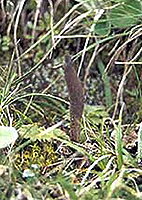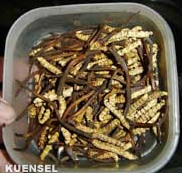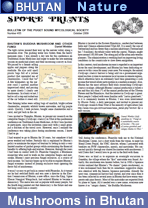| Cordyceps sinensis - Yartsa Goenbub in Bhutan |
| Highly
valued medicinal plant |
 |
Bhutan's Nature Yartsa Goenbub |
|
 |
Bhutan Information |
|
|
 |
| Studying
Cordyceps in Bhutan |
 |
| Collection
of cordyceps depending
on weather conditions |
 |
 |
Collection
of cordyceps, used as an ingredient in traditional medicine, cannot be
fixed for a particular season but will vary from year to year depending
on weather conditions, according to a team of experts that recently visited
the cordyceps growing sites in Lingzhi.
Addressing
the officials of the agriculture ministry, a biotech researcher from Thailand,
Dr. Nigel Hywel-Jones, said that temperature was the most important
criteria in development of the upper fungus part of cordyceps. |
If
winters are colder and longer than usual then the development of the fungus
is affected, he said. "Since there is no metabolic activity when temperature
is very low the fungus hibernate and doesn't grow," said a plant expert.
Apart
from elevation and temperature, the time during which the cordyceps are
collected affects the quality of the cordyceps, according to Dr. Nigel
Hywel-Jones. "Immature cordyceps are rated the most excellent, while maturing
and matured cordyceps are rated barely acceptable and poor in quality,"
said Dr. Nigel Hywel-Jones.
Starting
2002 the research project funded by Darwin initiative, UK, is trying to
study the life cycle of the cordycep larvae for sustainable management
of the cordyceps.
A
plant advisor from Renewable Natural Resources Center, Tshitila tsiad that
Bhutan lacked scientific knowledge and data on the cordycep. "The right
extraction rate, right collection time and right post harvest methods must
be known for a sustainable harvest," he said.
 |
Cordyceps Sinensis
There
are 400 species in the genus Cordyceps. Very few of these During the visit
to Lingzhi, live caterpillar were collected some of which will be taken
to the UK for research and some left in the research center in Yusipang,
to identify the host species of cordycep sinensis and also to identify
the host plants of the caterpillars in Bhutan. About four different species
of plants suspected of being the host plant for the caterpillars were noted
during the visit. |
|
 |
"The
plants will be planted in the herb garden in Yusipang and Lingzhi for further
research," said RNR officials.
The
research, RNR officials said, was a step towards sustainable management
of cordyceps through rearing of the species which according to experts
was a hard and long process.
Farmers
could also benefit from the research. Officials said that if cordyceps
harvesting was made feasible farmers could earn cash income.
Meanwhile
the agriculture ministry, to reduce the impact on the wild plant, limited
the collection period to June and also restricted the number of permits
to a maximum of two in some cordyceps harvesting villages and one in other
villages.
While
the team could not exactly say whether cordyceps were being collected indiscriminately,
they observed that the density of the cordyceps growth were about 5 per
square meter which was more compared to other neighbouring countries of
similar altitude having one cordyceps per square meter.
The
collectors had also informed the team that the growth of cordyceps fluctuated
from year to year. Extinction of the species was, however, near impossible
experts said. "Even though the cordyceps are collected in huge numbers
there are always some undetected cordyceps in pocket areas that would disperse
thousands of spores," said Tshitila adding that the number of growth for
the next season, however, would be affected.
 |
| This
article was contributed by Kinley Wangmo, Kuensel,
2005 |
| Mushrooms in Bhutan |
 |
|






